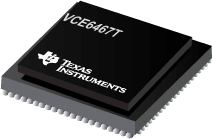Sistema de medios digitales en chip 529-FCBGA
PDF, 132 Kb, Archivo publicado: nov 13, 2009
This application report discusses the power consumption of the Texas Instruments TMS320DM6467T digital media System-on-Chip (DMSoC). Power consumption on the DM6467T device is highly application-dependent; therefore, a spreadsheet that estimates power consumption is provided along with this document. To obtain good results from the spreadsheet, realistic usage parameters must be entered (see Secti
PDF, 136 Kb, Revisión: D, Archivo publicado: marzo 4, 2011
This document describes the functionality of the TMS320DM6467 Digital Media System-on-Chip (DMSoC) ARM ROM bootloader (RBL) software. The ARM ROM bootloader resides in the ROM of the device beginning at address 0x00008000. The RBL implements methods for booting in the listed modes and uses boot configuration pins to determine boot mode. If an improper boot mode is chosen, or an error is detected d
PDF, 40 Kb, Revisión: B, Archivo publicado: jun 8, 2010
This application report describes an overview of the necessary changes to migrate a DM6467-based design from a DM6467 device (594 MHz or 729 MHz) to a DM6467T (1GHz) device. The DM6467T device requires the changes listed in this document for proper operation. Other system changes may be required to accommodate new speeds or capabilities in the system.
PDF, 85 Kb, Archivo publicado: feb 10, 2009
The DM6467 contains a PCI interface that allows connecting it to a PCI bus in order to communicate with the other peripherals in the system. The DM6467 PCI has a 32-bit data bus. The operating frequency is specified in the device-specific data sheet. This document shows different ways to interface DM6467 devices with the PCI bus.
PDF, 181 Kb, Revisión: A, Archivo publicado: abr 6, 2010
This application report has supplemental information about using the DM646x video port. The tips and tricks in this document are useful in video security applications as well as other applications that make use of the video port.
PDF, 119 Kb, Archivo publicado: feb 3, 2009
The Texas Instruments DM646x devices support interfacing to a peripheral component interconnect (PCI) bus through its PCI port. The system or the application may contain a PCI ExpressВ® interface. In order to connect the PCI Express bus to the DM646x PCI bus, an XIO2000A translation bridge is used. XIO2000A is a PCI Express to PCI/PCI-Xв„ў bus translation bridge.
PDF, 1.3 Mb, Revisión: A, Archivo publicado: mayo 27, 2008
Building a Small Embedded Linux Kernel Example Application Report
PDF, 969 Kb, Archivo publicado: sept 24, 2009
This application report describes the device differences to be taken care for running the C64x+™ video codec software on different C64x+ based platforms. This document assumes that the codec software is developed for the C64x+ digital signal processor (DSP) core. As many TI platforms have a C64x+ DSP this document gives the details for running the standalone codec software on a C64x+ platfo
PDF, 93 Kb, Revisión: A, Archivo publicado: jul 17, 2008
This application report motivates the way the DDR high-speed timing requirements are now going to be communicated to system designers. The traditional method of using data sheet parameters and simulation models is tedious. The system designer uses this information to evaluate whether timing specifications are met and can be expected to operate reliably.Ultimately, the real question the hardwa
PDF, 127 Kb, Archivo publicado: mayo 20, 2007
As integrated circuit (IC) components become more complex, the challenge of producing an end product with superior thermal performance increases. Thermal performance is a system level concern, impacted by IC packaging as well as by printed circuit board (PCB) design. This application report addresses the thermal considerations for the TMS320DM64xx, TMS320DM64x, and TMS320C6000в„ў DSP devices.
PDF, 310 Kb, Revisión: A, Archivo publicado: oct 20, 2005
This document describes migration from the Texas Instruments TMS320C64xв„ў digital signal processor (DSP) to the TMS320C64x+в„ў DSP. The objective of this document is to indicate differences between the two cores and to briefly describe new features. Functionality in the devices that is identical is not included. For detailed information about either device, see the TMS320C64x/C64x+ DSP
